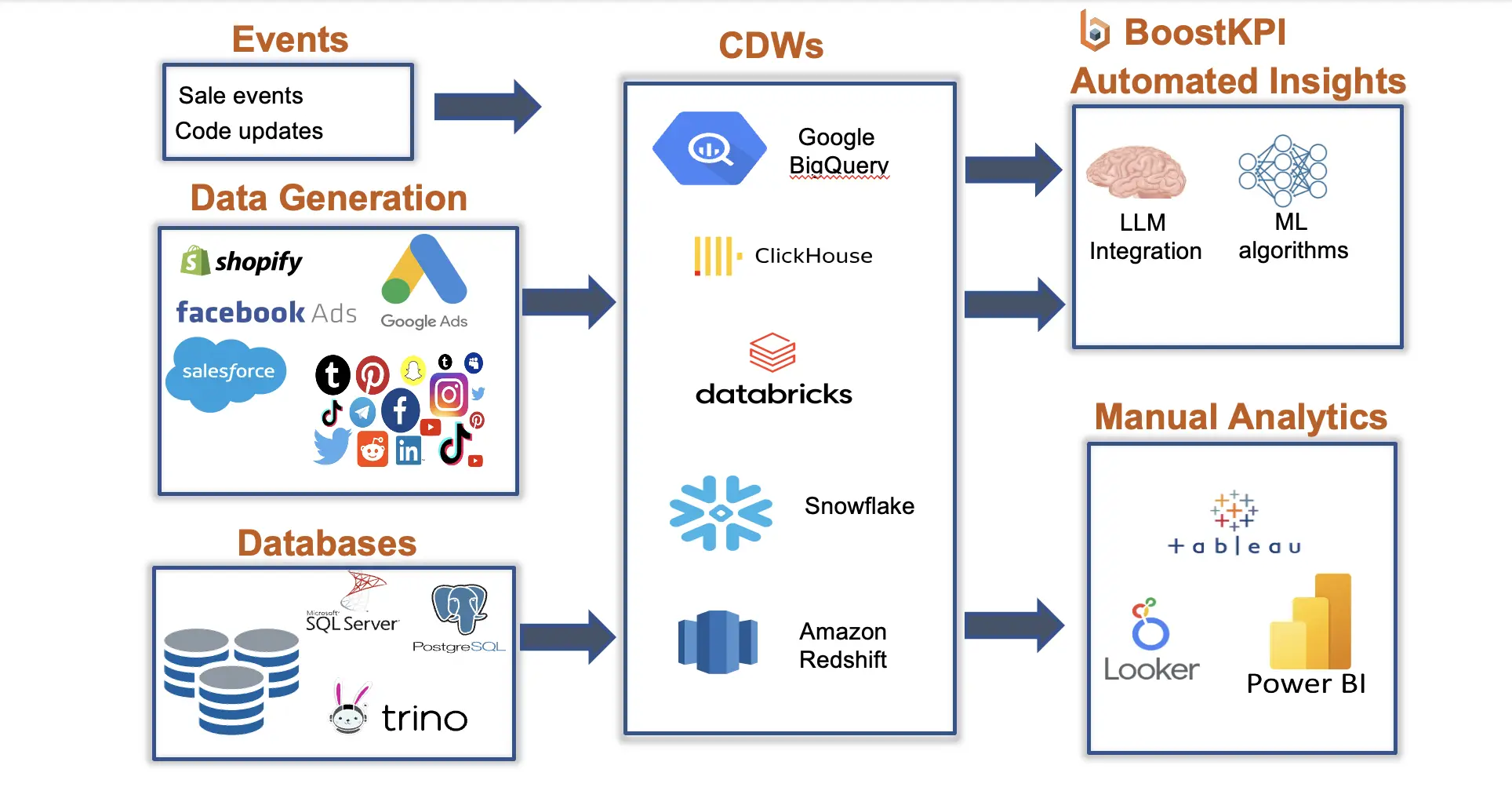The magic of Cloud Data Warehouses

Learn how Cloud Data Warehouses empower organizations with scalability and performance. Use BoostKPI for actionable insights on the CDW data.
The Modern Data Stack: How Cloud Data Warehouses Empower Organizations
The rise of the modern data stack signifies a paradigm shift in the world of data analytics. As organizations constantly evolve, they need agile and scalable tools to drive decision-making. At the heart of this revolution sits the Cloud Data Warehouse, acting as a hub and facilitating data integration, transformation, and reporting.
In this article, we’ll explore how companies are leveraging tools like StitchData, Supermetrics, TripleWhale, and BoostKPI to centralize their advertising data, analyze customer acquisition costs, and enhance decision-making capabilities.
1. Why the Cloud Data Warehouse is Central
Cloud Data Warehouses (CDW) like BigQuery, Snowflake, Databricks, or Redshift have changed the game in the following ways:
-
Scalability: CDWs can handle massive data volumes, allowing organizations to scale without having to worry about infrastructure bottlenecks.
-
Performance: Modern CDWs utilize parallel processing, ensuring quick query results irrespective of the data size.
-
Flexibility: They support multiple data formats, making integration from diverse sources effortless.
2. Push Storefront Data into CDW
For organizations that use a storefront like Shopify or WooCommerce, you can use tools like StitchData to push your revenue data into a CDW. This data can consists of your sales funnel, broken down by various dimensions, like geography, platform (iOS, Android, Desktop windows,or Desktop Chrome), platform version, or user segments (returning vs new users, household income etc).
For other organizations that maintain their own storefronts, they can push their data into a CDW after aggregating it.
3. Bringing Advertising Data into the Mix
Platforms like Facebook Ads and Google Ads offer valuable insights into customer behavior, but sifting through them separately can be cumbersome. Enter tools like:
-
StitchData: It provides a platform to ETL (Extract, Transform, Load) your data from various sources directly into your CDW.
-
Supermetrics: Known for its wide array of connectors, it can easily funnel your advertising data into the warehouse.
-
TripleWhale: Another fantastic tool to migrate data without writing any code.
These tools streamline the process, making it straightforward to consolidate and analyze advertising metrics centrally.
For engineering driven teams, you can use the reporting APIs these tools offer to download the data to a cloud data warehouse. Wish and many other large advertisers use this approach.
4. Joining LTV and CAC Data for Deeper Insights
With your advertising data centralized, it’s time to derive actionable insights. To do so, it is important to not just look at your Lifetime Value (LTV) in isolation but also compare it to your Customer Acquistion Cost (CAC) at a granular level. See here for details.
-
Merging Data: Use SQL commands to merge Lifetime Value (LTV) with Customer Acquisition Cost (CAC) data.
-
Segmentation: Segment the joined data by channel (e.g., Facebook, Google), by specific campaigns, geographies (country, state, DMA), or even by creative designs used in ads.
5. Exposing Data Insights with BoostKPI
Once your data is ready, tools like BoostKPI come into play:
-
Advanced Analytics: Dive deep into metrics to understand the performance of each channel, campaign, or creative.
-
Proactive Alerts: Instead of passive reporting, BoostKPI can actively alert the relevant stakeholders in the organization to anomalies or significant changes in KPIs, ensuring real-time response to any shifts.
-
Visualization: Convert complex data into understandable visuals, making it easier for stakeholders to interpret results.
6. Conclusion: The Power of the Modern Data Stack
With a CDW at the core and the integration of specialized tools like StitchData, Supermetrics, and BoostKPI, organizations are in a better position than ever to understand their customers, optimize their marketing strategies, and drive growth. The modern data stack isn’t just about collecting data—it’s about turning that data into meaningful, actionable insights that can drive a company forward.
So, as you look to the future of your organization’s data strategy, consider centralizing your approach around a Cloud Data Warehouse and harness the power of modern tools to unlock unparalleled insights.